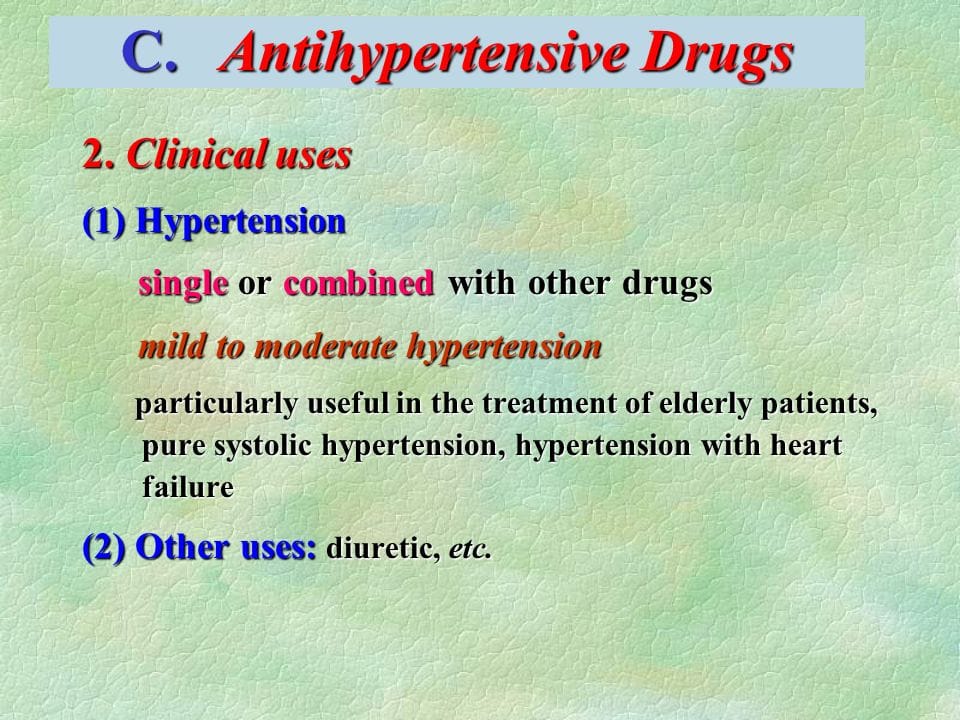|
Getting your Trinity Audio player ready... |
Antihypertensive: Hypertension and Antihypertensive Drug Use
Prevalence of Hypertension and Antihypertensive Drug Use
Antihypertensive medications are crucial for managing high blood pressure (hypertension), which is a major risk factor for cardiovascular diseases such as heart attacks and strokes. Studies indicate that even a slight decrease in blood pressure can significantly reduce these risks, by up to 33%.
In the United States, over 100 million people, nearly half of the adult population, are affected by high blood pressure, according to the American Heart Association.
In 2017, the guidelines for diagnosing hypertension were revised. Previously, a diagnosis required a blood pressure reading of 140/90 mmHg, but the new threshold is now 130/80 mmHg. As a result, many more individuals are now classified as hypertensive.
The statistics concerning cardiovascular diseases and their related conditions are alarming:
- Over 34 million Americans live with type 2 diabetes.
- More than 350,000 cardiac arrests occur outside of medical facilities each year.
- Nearly 40% of Americans were considered obese as of 2020, with 71.6% of adults being overweight.
- Nearly 800,000 Americans will experience a stroke annually.
- Over 16 million adults have coronary artery disease.
More concerning is the 38% increase in hypertension-related deaths between 2005 and 2015, underscoring the importance of antihypertensive drugs in clinical practice today. These medications, combined with proper diet and exercise, remain vital in managing high blood pressure.
Pharmacology of Antihypertensive Medications
Antihypertensive medications are used in various ways to reduce blood pressure. Some of the drugs discussed here are no longer first-line treatments, but they still have notable effects and are used in resistant hypertension.
The following antihypertensive drug classes are discussed:
- ACE Inhibitors
- Angiotensin II Receptor Blockers (ARBs)
- Diuretics
- Calcium Channel Blockers (CCBs)
- Beta-Blockers
- Alpha-Blockers
- Alpha-2 Agonists
- Renin Inhibitors
- Vasodilators
- Endothelin Receptor Antagonists
1. ACE Inhibitors
ACE inhibitors are commonly prescribed for cardiovascular conditions, particularly hypertension.
Examples:
- Ramipril
- Lisinopril
- Perindopril
Mechanism of Action: These medications block the angiotensin-converting enzyme (ACE), reducing the production of angiotensin II. This lowers blood pressure by reducing blood volume and causing vasodilation.
Side Effects:
- Hypotension, especially after the first dose
- Persistent dry cough
- Hyperkalemia (high potassium)
- Fatigue, dizziness, nausea
Because ACE inhibitors can increase potassium levels, they should not be used with potassium supplements or other potassium-raising drugs.
2. Angiotensin II Receptor Blockers (ARBs)
ARBs are often used when ACE inhibitors cause undesirable side effects like persistent cough.
Examples:
- Candesartan
- Losartan
- Irbesartan
Mechanism of Action: ARBs block the action of angiotensin II on its receptors, which helps to relax blood vessels and reduce blood pressure.
Side Effects:
- Hypotension
- Hyperkalemia
- Kidney issues (renal failure)
- Less likely to cause a cough compared to ACE inhibitors
3. Diuretics
Diuretics are used to help the body eliminate excess salt and water, lowering blood volume and pressure.
Examples:
- Furosemide (loop diuretics)
- Hydrochlorothiazide (thiazide diuretics)
Mechanism of Action: Diuretics work on different parts of the kidney to remove excess sodium and water, which helps reduce blood pressure.
Side Effects:
- Loop diuretics: dehydration, low potassium
- Thiazides: dehydration, electrolyte imbalances
- Potassium-sparing diuretics: high potassium levels
4. Calcium Channel Blockers (CCBs)
CCBs are first-line treatments for hypertension, particularly dihydropyridines.
Examples:
- Amlodipine (dihydropyridine)
- Diltiazem (non-dihydropyridine)
Mechanism of Action: These drugs block calcium channels, which helps relax blood vessels, reduce heart rate, and decrease blood pressure.
Side Effects:
- Flushing
- Ankle swelling
- Constipation (with verapamil)
- Rare: Bradycardia and heart failure
5. Beta-Blockers
Beta-blockers are usually used when hypertension is resistant to other treatments.
Examples:
- Metoprolol
- Bisoprolol
Mechanism of Action: These medications block beta receptors, reducing heart rate and the amount of blood pumped by the heart, which lowers blood pressure.
Side Effects:
- Fatigue
- Cold extremities
- Impotence in men
6. Alpha-Blockers
Alpha-blockers are used for resistant hypertension and work by relaxing blood vessels.
Examples:
- Doxazosin
- Tamsulosin
Mechanism of Action: These drugs block alpha-1 receptors, leading to vasodilation and reduced blood pressure.
Side Effects:
- Dizziness
- Postural hypotension (especially after the first dose)
7. Alpha-2 Agonists
Alpha-2 agonists are occasionally used in resistant hypertension, often with a diuretic.
Examples:
- Clonidine
- Methyldopa
Mechanism of Action: These drugs act in the brain to reduce sympathetic nervous system activity, which relaxes blood vessels and lowers blood pressure.
Side Effects:
- Sedation
- Dry mouth
- Rebound hypertension
8. Renin Inhibitors
Renin inhibitors work by blocking the initial step in the renin-angiotensin-aldosterone system, lowering blood pressure.
Example:
- Aliskiren
Mechanism of Action: By inhibiting renin, these drugs reduce the production of angiotensin II, lowering blood pressure.
Side Effects:
- Hyperkalemia
- Diarrhea
- Dizziness
9. Vasodilators
Vasodilators directly relax blood vessels, decreasing resistance and lowering blood pressure.
Examples:
- Hydralazine
- Sodium nitroprusside
Mechanism of Action: These medications work by dilating the arteries and veins, which decreases blood pressure.
Side Effects:
- Hypotension
- Tachycardia
- Cyanide poisoning (with sodium nitroprusside)
10. Endothelin Receptor Antagonists
These drugs block the endothelin-1 receptor to reduce blood pressure, particularly in pulmonary hypertension.
Example:
- Bosentan
Mechanism of Action: By blocking endothelin receptors, these drugs decrease vascular resistance in the lungs, lowering pulmonary blood pressure.
Side Effects:
- Liver toxicity
- Edema
- Teratogenic effects (should be avoided in pregnancy)
Conclusion
This overview of antihypertensive medications highlights their essential role in managing high blood pressure, which is a significant risk factor for cardiovascular diseases. As new treatments and guidelines continue to emerge, understanding the pharmacology of these drugs remains critical for effective patient care.

